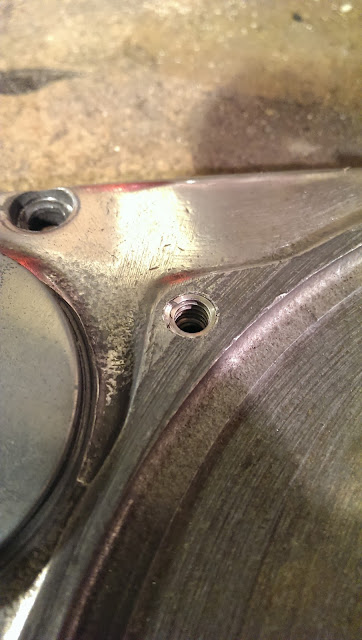Updated: First published January 2014
Well, I knew I shouldn't have looked too closely at those calipers. I replaced one nipple successfully:
The other one is too far gone and I am going to need to Helicoil it. Time to resurrect an old post that I published a long while ago:
So you've all seen how the trial fit up of the primary cases revealed some duff threads that I really should have seen earlier - well now we have to fix them.
Well, I knew I shouldn't have looked too closely at those calipers. I replaced one nipple successfully:
The other one is too far gone and I am going to need to Helicoil it. Time to resurrect an old post that I published a long while ago:
So you've all seen how the trial fit up of the primary cases revealed some duff threads that I really should have seen earlier - well now we have to fix them.
I bought this nice little set from Chronos:
It comes in a nice little steel box with all the tools you need and 20 or so helicoils, for less than £15 delivered. These are 1/4" BSW.
Here are the drill, tap & a helicoil insert:
The first step is to drill out the hole to the correct tapping size for the outside diameter of the insert. It is vital to use the correct drill bit size, as the outer thread of the helicoil will match the newly tapped hole, and will dictate the size of the internal thread such that it matches your fastener.
You need the screw to ultimately go into the work at the proper angle, so if you can, set the work up in a drill press.
Next you have to cut the thread for the outside of the insert using the tap that is provided with the kit. The tap has a short taper (called a 'second' tap) to help get the thread started; use a tap wrench (90 degrees forward, 120 degrees back to clear the swarf) with some lubrication to cut the new thread. Cut the thread until you no longer feel any resistance as this means the hole is now completely tapped with the new thread. Gently wind out the tap with the wrench. Make sure you don't try to bend it at any time - you really don't want to have to deal with a broken tap.
Next take one of the helicoil inserts and put it over the end of the installation tool, with the tang of the inset in the slot and in what will become the bottom of the hole - so the tang goes in the hole first. Set the depth stop so the insert will end up 1/2 a pitch below the surface.
Wind it in. You shouldn’t feel any resistance as you do this but if you do you may just need to clean the thread up a little. Note that as you get near the bottom of the hole and the friction increases you will feel the insert start to wind up, spring like, against the tool.
One the coil is in place you use the little punch that should come with the kit to knock the little tang off the end of the helicoil that assisted with winding it in. If you are rethreading something relatively thin, as is the situation with this primary chaincase, you can grind off the spare length of insert with the Dremel:
Job done:
Next you have to cut the thread for the outside of the insert using the tap that is provided with the kit. The tap has a short taper (called a 'second' tap) to help get the thread started; use a tap wrench (90 degrees forward, 120 degrees back to clear the swarf) with some lubrication to cut the new thread. Cut the thread until you no longer feel any resistance as this means the hole is now completely tapped with the new thread. Gently wind out the tap with the wrench. Make sure you don't try to bend it at any time - you really don't want to have to deal with a broken tap.
Next take one of the helicoil inserts and put it over the end of the installation tool, with the tang of the inset in the slot and in what will become the bottom of the hole - so the tang goes in the hole first. Set the depth stop so the insert will end up 1/2 a pitch below the surface.
Wind it in. You shouldn’t feel any resistance as you do this but if you do you may just need to clean the thread up a little. Note that as you get near the bottom of the hole and the friction increases you will feel the insert start to wind up, spring like, against the tool.
One the coil is in place you use the little punch that should come with the kit to knock the little tang off the end of the helicoil that assisted with winding it in. If you are rethreading something relatively thin, as is the situation with this primary chaincase, you can grind off the spare length of insert with the Dremel:
Job done:












Most of my holes weren't stripped, I helicoiled those that were - but I went to 1/4" USC (american coarse thread). This has the same diameter and pitch - 13 tpi - but a 60 degree angle. This has means the worn 55 degree BSW threads can be chased with a USC tap to clean them up, and tools and case screws (black allen drive) are all off the shelf at the local hardware store. I'm in the US now, last bastion of inch measurements, which helps. This is not original but my bike has never been a trophy winner (except mileage and RAT awards, long ago).
ReplyDeletebrain fart - I meant 20TPI
ReplyDelete